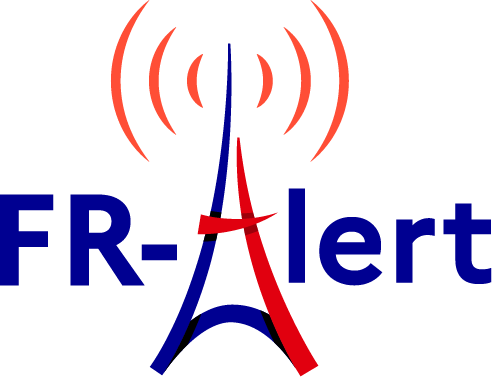FR-Alert, a European reference combining Cell Broadcast and Location-Based SMS
- October 18, 2022
- Categories: Disaster management, Public warning
French version below / version française ci-dessous
“Our ambition is to build a solution that will be a European reference”: these are the words used by Romain Moutard, program director at the Ministry of Interior, to describe the new national alert system in France, FR-Alert.
The deployment of the system was piloted by the Ministry of Interior and the DGSCGC – General Directorate for Civil Security and Crisis Management, the technological partner Intersec, all the mobile operators in metropolitan France and the French overseas territories, as well as various industrial and institutional partners, with a common ambition: to deploy a bold and modern alert system to tackle the risks of today and tomorrow.
In the event of an ongoing or imminent danger, FR-Alert enables the Ministry of Interior and the prefectures to broadcast targeted and contextualised warning messages very quickly to the population’s mobile phones.
A major technological breakthrough
In response to European regulatory compliance, the French government wished to go beyond the EU standards and regulations. By defining its own requirements to take advantage of cutting-edge technologies that have appeared on the market in recent years, the government is improving the effectiveness of crisis management and the safety of everyone.
France has chosen to use both location-based SMS (LB-SMS) and cell broadcast (CB). By combining these two technologies, the coverage rate reaches 95% of the French population and makes it possible to manage a wider variety of situations.
The solution implemented enables the ministry’s teams to integrate new functionalities with agility to alert and manage crises ever more effectively: advanced supervision of systems that are part of the national alert architecture, ever finer interfacing with the State’s various Government Information Services, real-time heat maps, etc. The system is intended to develop the country’s resilience over time and to be enriched over the years.
A truly multi-channel system
In the event of a serious event, crisis management cannot be limited to sending a single message, however widely it may be disseminated. In view of the climate risks, the current geopolitical dynamics, and on the eve of the 2024 Olympic Games, the French government wished, from the outset, to integrate a whole series of communication channels to be able to reach as many people as possible in all circumstances.
So the system does not just send notifications to the mobile phones of people present in an area facing danger. The application portal of the Ministry of Interior is actually called “Multichannel Alert Portal”. It integrates and consolidates existing distribution channels such as the 2,200 outdoor warning sirens under the population alert and information system (SAIP) and publications on social networks, as well as new communication channels: an official alert website, the possibility of registering addresses of interest in order to receive the corresponding alerts by SMS or email, the forthcoming integration into the Galileo satellite system, etc.
Territorial and cultural complexity
Metropolitan France and its overseas territories have more than 67 million inhabitants and nearly 90 million international tourists each year: as many geographical, cultural, and technological disparities, with associated risks that must be considered and covered.
In addition to prevention, the French public authorities have a fundamental challenge to educate people and make them aware of the risks, because one in four inhabitants and one in three jobs are exposed to natural risks, and more than half of the French people are affected by a natural risk are not informed about it. In order to develop a risk culture in France, it is necessary to anchor the reality of risk in the shared memory of society and the habits to adopt in the face of these situations. In France, “Erika”, “AZF”, “Lubrizol”, “Katrina”, “Irma” and others are imprinted in the local collective unconscious and are gradually improving knowledge and procedures.
It is essential to raise citizens’ awareness beforehand so that they do not discover the alert procedures on the day of the disaster, without knowing the behaviour to adopt. Adapting to the context, designing messages that are intelligible to all, evaluating the perception of different warning messages, proposing exercises to the population, collecting testimonies from inhabitants, clarifying the regulatory framework… these are all subjects that have been carried out collaboratively by the public and private contributors to the project.
We are fully committed to the public interest issues to support the Ministry of Interior and the other players involved in proposing a solution that combines technological efficiency and citizens’ confidence in alerts and, more generally, to create a genuine risk culture in France. This also includes the support to local authorities, town halls and inter-municipalities which are responsible in France for alerting, informing, and protecting the population in the event of serious danger, and for organising emergency services in their commune.

FR-Alert, une référence européenne en combinant Cell Broadcast et SMS géolocalisés
« Nous avons l’ambition de construire une solution qui sera une référence européenne. », Ce sont les mots employés par Romain Moutard, directeur de programme au Ministère de l’Intérieur, pour qualifier le nouveau dispositif national d’alerte en France, FR-Alert.
Le déploiement du dispositif a été piloté par le ministère de l’Intérieur et la DGSCGC – direction générale de la sécurité civile et de la gestion de crise -, le partenaire technologique Intersec, l’ensemble des opérateurs mobiles métropolitains et ultra-marins, ainsi que divers partenaires industriels et institutionnels, autour d’une ambition commune : déployer un système d’alerte audacieux et moderne pour faire face aux risques d’aujourd’hui et de demain.
En cas de danger en cours ou imminent, FR-Alert permet notamment au Ministère de l’Intérieur et aux Préfectures de diffuser de manière très rapide des messages d’alerte ciblés et contextualisés sur les téléphones mobiles de la population, en France métropolitaine et dans les territoires ultra-marins.
Une avancée technologique majeure
En réponse à la mise en conformité réglementaire européenne, l’Etat français a souhaité aller au-delà des standards et du texte de l’UE. En définissant ses propres exigences afin de tirer parti des technologies de pointe apparues sur le marché ces dernières années, le gouvernement améliore l’efficacité de la gestion de crise et la sécurité de tout un chacun.
La France a par exemple fait le choix conjoint des SMS géolocalisés (LB-SMS) et de la diffusion cellulaire (CB). En combinant ces deux technologies, le taux de couverture atteint 95 % de la population française et permet de gérer une plus grande variété de situations.
La solution mise en place permet aux équipes du ministère d’intégrer avec agilité de nouvelles fonctionnalités pour alerter et gérer les crises toujours plus efficacement : supervision avancée des systèmes partie à l’architecture national d’alerte, interfaçage toujours plus fin avec les différents SIG de l’Etat, cartes de chaleur en temps réel… Le système a vocation à développer la résilience du pays dans le temps et à s’enrichir au fils des ans.
Un dispositif résolument multicanal
En cas d’événement grave, la gestion de crise ne peut se limiter au seul envoi d’un message, aussi large sa diffusion soit-elle. Face aux risques climatiques, aux dynamiques géopolitiques actuelles, et à la veille des JO 2024, le gouvernement français a souhaité, dès le début, intégrer tout une série de canaux de communication afin d’être en mesure de toucher le plus grand nombre de personnes en toutes circonstances.
Le système ne se contente donc pas d’envoyer des notifications sur les téléphones portables des personnes présentes dans une zone confrontée à un danger. Le portail applicatif du Ministère de l’Intérieur est d’ailleurs baptisé « Portail d’Alerte Multicanal » (PAM). Il intègre et consolide les canaux de diffusion existants comme les 2 200 sirènes relevant du système d’alerte et d’information des populations (SAIP) et la publication sur les réseaux sociaux, ainsi que de nouveau canaux de communication : un site web officiel d’alerte, la possibilité d’enregistrer des adresses d’intérêt pour recevoir les alertes correspondantes par SMS ou emails, l’intégration prochaine au système satellitaire Galileo, etc.
Une complexité territoriale et culturelle
La France métropolitaine et les territoires ultra-marins comptent plus de 67 millions d’habitants et près de 90 millions de touristes internationaux chaque année : autant de disparités géographiques, culturelles et technologiques, avec les risques associés particuliers qui sont donc à considérer et à couvrir.
Au-delà de la prévention, les pouvoirs publics français ont donc un enjeu fondamental d’éducation, d’acculturation au risque car un habitant sur quatre et un emploi sur trois sont exposés à des risques naturels, et plus de la moitié des Français concernés par un risque naturel ne se tiennent pas informés sur ce risque. Pour développer une culture du risque en France, il y a nécessité d’ancrer la réalité du risque dans la mémoire partagée de la société et des réflexes à adopter face à ces situations. En France, « Erika», « AZF », « Lubrizol », « Katrina », « Irma »… sont imprimés dans l’inconscient collectif local, et font progresser, peu à peu, la connaissance et les pratiques.
Il est indispensable de sensibiliser les citoyens en amont, pour qu’ils ne découvrent pas les procédures d’alerte le jour du drame, sans connaitre non plus les comportements à adopter. S’adapter aux contextes, concevoir des messages intelligibles pour tous, évaluer la perception de différents messages d’alerte, proposer des exercices aux populations, recueillir les témoignages des habitants, clarifier le cadre réglementaire… ce sont autant de sujets qui ont été portés collaborativement par les contributeurs publics et privés du projet. Nous sommes pleinement engagé dans les problématiques d’intérêt général pour accompagner le ministère de l’Intérieur et les autres acteurs impliqués pour proposer une solution qui conjugue efficacité technologique et confiance des citoyens dans les alertes et, plus généralement, pour faire naître en France une véritable culture du risque. Cela concerne également les collectivités locales, mairies et intercommunalités qui ont une responsabilité, en France, d’alerter, d’informer et de protéger la population en cas de danger grave, et d’organiser les secours dans leur commune.
The opinions expressed are those of the author and do not necessarily represent the views of EENA. Articles do not represent an endorsement by EENA of any organisation.

Charlotte Cardona
- Charlotte Cardona#molongui-disabled-link
Share this blog post on:
